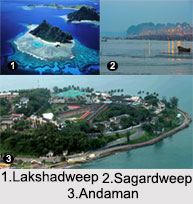 Tourism in Island Cities in India covers leisure tourism. Not only this, these islands are proper escapades to get fresh air, calm and serene beaches and the luxury hotels, farm houses, boutique hotels and resorts. Majuli Island in North eastern part of India to the Andamans in the east and Lakshadweep in the west are most unique islands which allures global tourists for its natural beauty.
Tourism in Island Cities in India covers leisure tourism. Not only this, these islands are proper escapades to get fresh air, calm and serene beaches and the luxury hotels, farm houses, boutique hotels and resorts. Majuli Island in North eastern part of India to the Andamans in the east and Lakshadweep in the west are most unique islands which allures global tourists for its natural beauty.
Tourism in Majuli Island
Majuli Island is the one of the biggest river islands in the world. It is located in Assam. The most unique of all islands in India, this place is famous for its breathtaking sunrises and stunning sunsets. One can also take the flavor of Assamese culture also. The best time to visit Majuli is from October to December.
Tourism in Lakshadweep
Water sports, adventure sports and luxury- all one can find in Lakshadweep. A Union Territory of India, Lakshadweep Islands play a vital role in generating income, employment and over all development in tourism. Lakshadweep Islands were referenced also in the Buddhist Jataka stories of the 6th century BC. The arrival of Muslim missionaries around 7th century led to the advent of Islam in the region. During the medieval period the region was ruled by the Chola dynasty and Kingdom of Cannanore. The Portuguese arrived around 1498 and were upstaged by 1545. The region was then ruled by the Muslim house of Arakkal, followed by Tipu Sultan. On his death in 1799 most of the region passed on to the British and with their departure the Union Territory was formed in 1956. Water sports activities in Lakshadweep such as scuba diving, wind surfing, snorkeling, surfing, kayaking, canoeing, water skiing, sport fishing, yachting and night-voyages into the sea are quite popular activities among tourists. The tourists flock to these islands throughout the year except during the South-west monsoon months when seas are extremely rough.
Tourism in Sagardweep
It is a small island in West Bengal and it is known as the pilgrimage destination, because of the presence of many Hindu ashramas and the famous Kapil muni Temple. Every year on the day of Makar Sankranti (14 January), hundreds of thousands of Hindus gather to take a holy dip at the confluence of river Ganges and Bay of Bengal and offer prayers in the Kapil Muni Temple. Gangasagar mela and pilgrimage is held annually on Sagar Island"s southern tip, where the Ganga River enters the Bay of Bengal.
Tourism in Andaman
Tourism is a major industry in Andaman and Nicobar Islands. This group of islands has Ross Island, Viper Island, Havelock Island and Radhanagar Beach. The adventure tourism includes trekking, island camping, snorkeling and scuba diving. These are now the major tourism attractions.



















